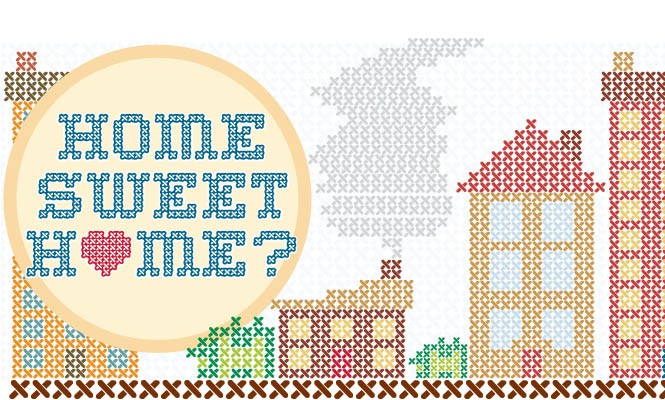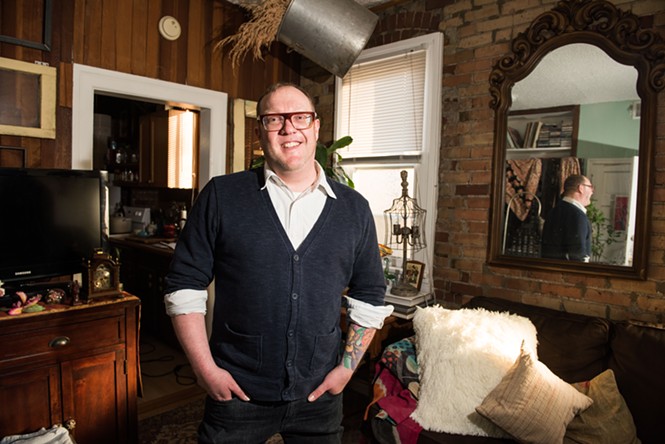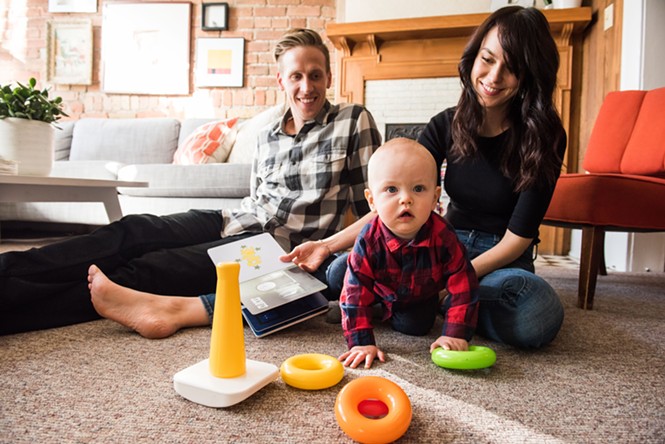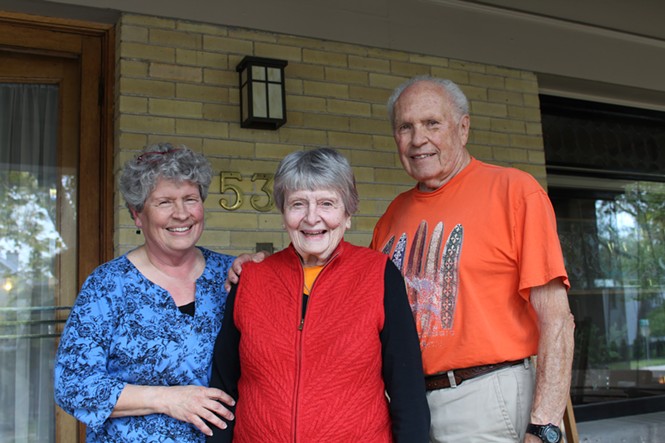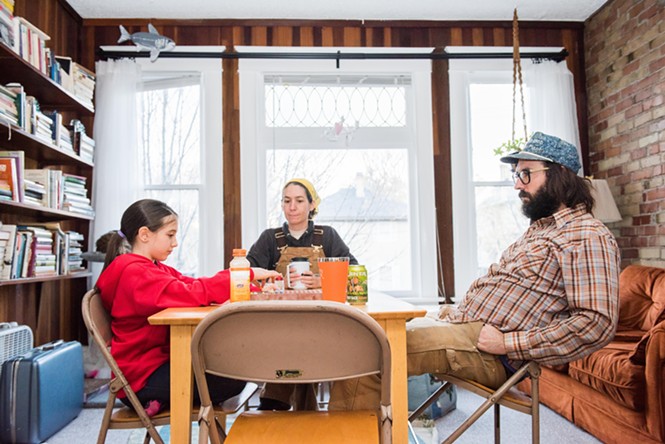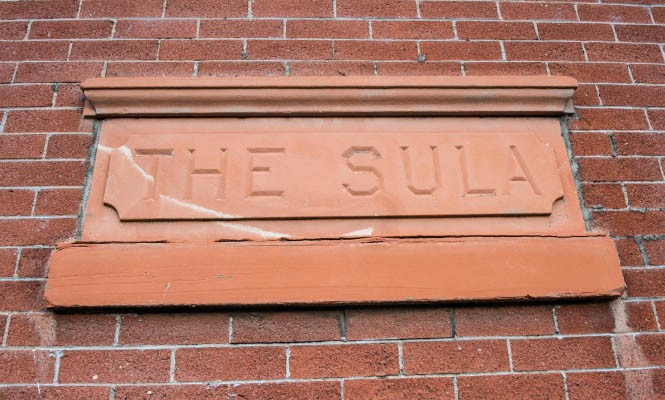Home Sweet Home?
How a single real estate deal highlights a city in flux and in crisis.
By Colby Frazier @colbyfrazierlpIt was by accident that Dick and Jean Raybould came to own the SULA apartment building at 60 E St. in the Avenues neighborhood of Salt Lake City.
In January of 1974, Dick's brother told him that he was owed $10,000—an amount that could not be paid in any currency besides the seven-unit, red brick apartment that has, since 1909, been anchored between First and Second Avenue.
Apartment No. 66 had been charred by fire sometime that winter. Water remained on the floor, and it needed to be rebuilt, which is where Dick fit in. His brother would accept the building as payment for the debt only if Dick agreed to rebuild the burned-out apartment—a challenge he accepted, and one that earned him an ownership stake in the building and a long career as an accidental landlord and maintenance man.
It has been a decade since Dick, 88, has been permitted to stand atop a ladder and perform maintenance work on the building. And his daughter, Robyn Raybould, 62, who has acted as de-facto maintenance manager for years, has long been looking forward to the day when she could move out of state to be closer to her grandchildren.
And so, by the accident of age and time's relentless passage, the Rayboulds sold their proud building last summer, a building where, for the past two years, I have lived with my family.
The sale of the SULA, a name that no one seems to know the exact meaning of (Dick believes it could be an acronym for Single Unit Lease Agreements, while Robyn likes to think it is a term for a water bird), sent a wave of change through the lives of many who called the place home. And it also became a metaphor of sorts for Salt Lake City's housing crisis, where rental vacancy rates are at a scant 2.5 percent, homelessness is on the rise and because housing demands exceed supply, prices are soaring.
Rather than reporting on the city's housing issues from the bureaucratic heights of cold numbers and statistics, this story is one of a single real estate deal in a single city that is, apparently at the same time, growing into and out of itself. And, just like many American cities, Salt Lake City is experiencing a wave of prosperity for some, while many others are being minced by the jaws of basic market economics.
At the SULA—whose new owners, SEPR Real Estate LLC, did not respond to requests to comment for this story—four of the seven tenants moved out upon being notified that their rents would, in some cases, double, and in other instances, be raised by around 40 percent. Other tenants interviewed said they had plans to vacate in the near future.
For me, the $850 I was paying for a spacious two-bedroom place, replete with the masonry walls and other charms of the SULA, but lacking amenities like washing machines and off-street parking, was hiked to $1,350 per month.
Like my neighbors, I anticipated that a rent hike, courtesy of new ownership, was imminent. But $500 more a month? This amount was surprising, depressing and, ultimately, far more than I could afford.
As I waded into the rental market, I found several things to be true, including the fact that renting in Salt Lake City was no longer a game that I could play. According to Mike Akerlow, director of the city's Housing and Neighborhood Development Division, more than 50 percent of the city's renters pay more than 30 percent of their income on housing. Once housing costs exceed 30 percent of one's income, this housing is considered unaffordable. And in Salt Lake City, where Akerlow says about 50 percent of the city's residents are renters, this means that a good number can't afford where they're living.
So I set out to buy, begging and borrowing money from as many loved ones as I could to come up with a down payment.
As my wife, daughter and I searched for homes, though, it became apparent that our loss in an affordable place to live would soon spiral into a lucky gain that would almost inevitably morph into another person's loss. This pattern, I imagined, would repeat itself until, somewhere down the line, a person less lucky than I would end up homeless.
It is this cycle—the loss of affordable units to increasing housing values and escalating rents—Akerlow says, that the city, which has declared an affordable housing crisis and is preparing to spend tens of millions on affordable housing initiatives, does not have a handle on.
"With the timing of our market here, the increase in home sale prices and rental rates, we are taking existing affordable housing and making it more expensive," he says. "The housing we are building is too expensive, so we're out of options. There's always a problem if you've got people living in your city who can't afford to live in their homes."
APT. NO. 62A
For the past seven years, David Ashton has lived in a small one-bedroom apartment in the SULA. Like many residents here, Ashton was notified at the beginning of October that his rent would be increased, and that he had 20 days to notify the new owners if he planned to stay or go.
"They raised my rent by $500 and that's kind of life-changing right now," says Ashton, who was paying $450.
Like many of his neighbors, Ashton considers SULA, and the wider Avenues neighborhood, his home. He works downtown in retail management, and for a number of years, he didn't need a car and walked everywhere he went.
But the SULA, under the stewardship of the Rayboulds, became an affordable sanctuary when Ashton fell ill with a genetic issue, forcing him to undergo open-heart surgery.
"Having a place like this helps me survive because rent was affordable," Ashton says. "I would be homeless if I didn't have this building. That's how this place has affected me. It's been my home for the last seven years."
When Ashton underwent surgery, he was a couple of weeks late on rent. The landlords, he said, told him not to worry and to pay when he could. When he returned to his apartment from the hospital, he says that Robyn Raybould had made him cookies.
A couple of years ago, Ashton says he was short on rent money and asked the Rayboulds if there was anything he could do to help make up the gap. He stained the fence and helped Robyn with various maintenance projects and, he says, rent for that month was waived. "They were really, really great to rent from."
Ashton says he can't afford to pay the new monthly rent of $950. But when he began his search for a new place, he found that over the past seven years, rental prices had skyrocketed.
"I kind of expected to find something for $750-ish for a one bedroom," Ashton says. "I've been shocked to find everything $850, $900, $1,100. I'm trying to figure out a new budget."
Aside from having to leave the SULA, Ashton is also disappointed that he might have to leave the Avenues, a neighborhood he has called home for 16 years. He enjoys walking to the liquor store, only a few blocks up E Street, and the Smith's Marketplace grocery store.
"I've often said to people, 'I have no reason to leave the Avenues, everything I need is here,'" he says. "It's my home. It's super sad."
PRIORITIES
Dick Raybould says that after he took over ownership of the SULA, prior owners had racked up a series of high-interest loans on the place, which he inherited. But once these were paid off, the building became a reliable source of income for his family.
The Rayboulds realized that consistency in renters was the key to, not only their happiness, but to the happiness of their renters as well.
And so when someone was fortunate enough to snag an apartment in the SULA, their rent began at or near fair-market value, but was never raised.
"Our first priority was having renters that tell you if the plumbing's leaking so you can get over and get it fixed right now," Dick Raybould says. "Once we had it fully rented, the name of the game was to keep it fully rented, then it became a cash cow."
In four decades, the Rayboulds have only ever had to ask two renters to leave; one exited in a huff, the other with grace. And at two years, my tenure at the SULA was by far the slimmest, as I shared walls with a woman—who asked that her name be withheld—who lived there for 12 years, Ashton for seven, and Gloria for 10.
Dick Raybould, who retired from a military career but who had always been taken by architecture, says his love for the SULA stemmed from its design. The two-bedroom apartments feature large living and dining rooms, their own front doors and back doors, and small bedrooms.
"I just liked the building," he says. "It's a great, solid, brick building. I like the architecture of it, with the private entrance, private exit in the rear; it looked like a place I'd like to live."
While the SULA has always been rich in character and charm, Robyn Raybould says that she didn't feel the need to charge high rental prices, and also didn't feel bad levying less than market rate, because the units lacked many of the amenities renters might expect if paying top dollar.
It's difficult to know the situation of the new owners, who seemed like nice enough people. Real estate website Zillow shows that the SULA sold in July for $699,900. The Rayboulds said that they received upward of 20 offers for the property, and went with the eventual buyers because they wrote a nice letter, and seemed genuine when they insinuated that their ambitions were not to simply flip the place.
Dick Raybould notes that during the sale, a real estate agent remarked that it was kind of him to provide charity housing for people. While some of the rates were undoubtedly low, Robyn Raybould says her father's ethos, when it came to his tenants, was to hold onto them as long as possible.
"Dad didn't like to kick people out. He listened to everyone's life," Robyn Raybould says. "Different people were in different places. We cared about the people and we didn't raise the rent and everybody was happy."
APT. NO. 68
At 65, Amy, who asked that her real name be withheld from the story, has lived at the SULA since 2004, paying $650 for her two-bedroom apartment.
Over the years, Amy's son, and her grandson, have lived with her. And every Sunday, Amy walks to the Cathedral of the Madeleine on South Temple, just a few blocks from her place, to take her grandson to church.
Her apartment, she says, is everything to her. "I get very attached to where I live," she says. "This is my home, I'm protected; I feel protected by these four walls. I loved this apartment and I loved being secure. All that shattered when they sold this building."
Amy was one of the first SULA tenants to receive notice that her rent was being raised, and she says the increase of $450 per month sent her into a state of shock. Amy approached my wife and I, asking if our rent had been increased as well. When we said no, she seemed hurt and wondered aloud why the new landlords were singling her out.
I tried to assure her that I had faith that soon, my rent, too, would be increased.
But these assurances didn't seem to soothe Amy's anger. Like Ashton and myself, she turned to a rental market that seemed to have left her in the dust. She says her searches for a comparable place in the neighborhood yielded options ranging $1,100-$1,300.
"Who can imagine coming up with $500 more a month in rent?" she asks.
Amy liked the Rayboulds because they didn't hassle her, and they kept the rent low. In exchange for the low rent, Amy says she felt comfortable buying new blinds and going without amenities like a dishwasher.
And the SULA cast its spell on her, she says, charming her with its big front windows that allow the sun to pour in, the brick walls and her patio, where she planted flowers.
Amy knows, just as Ashton knows, that the Rayboulds were giving them a screaming deal. Dick even let Amy pay her rent in two monthly chunks because it was hard for her to make a lump sum payment.
"They were just wonderful landlords," she says. "We loved this neighborhood. We love this area and I don't want to leave this area."
Amy says that she had a small savings that she used to pay a couple of months' rent at the SULA while she continued her search for a place. Short of that savings, though, she says she doesn't know what she would have done.
She says that her experience at the SULA has opened her eyes to how a person could end up on the street.
"Losing where you live is not fun; it makes you sick," she says. "This is how people get homeless."
APT. NO. 62B
Gloria was the first resident I met at the SULA; we shared a patio that overlooked E Street, where every single morning, horns blare in the street as traffic overflows from the popular Java Jo's drive-thru coffee shop.
For Gloria, life at the SULA has lasted 10 years. Ashton got his place in the building, just across the hall from Gloria, because she recommended him to the Rayboulds. The $475 per month she paid over those years was raised last October to $950—an amount that she says is going to force her to grow up and look at buying a place.
"I was expecting them to raise the rent by maybe a couple hundred bucks, but I definitely wasn't expecting double," she says.
Gloria has lived in the Avenues for 20 years, and she says the neighborhood feels like home. When she needs groceries, she feels comfortable heading to Smith's in her pajamas.
The Rayboulds, Gloria says, were kind to her. Shortly after moving in, she dropped something into her sink, cracking the porcelain. Dick replaced it, but a short time later, Gloria says she broke the new one. She fessed up and told Dick that before she left town for a vacation, she would leave some money for a new sink. When she returned, not only had the sink been replaced, but the countertop as well.
When Gloria attempted to find a new place to live, she says she was greeted by the same reality as other SULA residents: Rent had shot up to the point where it was difficult to justify renting.
"It's painful to pay double the price for the same place," Gloria says. "It's just changing times. I was really surprised by how much the rents have gone up in this area. That's one of the shockers. It'll be sad to move from the Avenues. There's a good chance that I'm going to have to move from the Avenues because it's too expensive."
APT. NO. 66
Kirk and Alex Campbell moved into the SULA shortly after marrying in 2009. Earlier this year, Alex gave birth to a baby boy, Rocky, who on summer nights, when all of the windows were open, I could sometimes hear crying.
"This is the only place we've ever lived," Alex says of her time being married to Kirk, and the new addition to the family.
Alex says the SULA's close proximity to the University of Utah came in handy when she was a student there, and now, it is close to her job downtown. And $700 a month for a two-bedroom apartment was pretty reasonable even in 2009.
The couple work opposite schedules, and currently can swing it so that Rocky is with one of them while the other is at work. As they have mulled moving, they say that it is difficult to find an affordable place to live in the neighborhood, but the further they branch out away from their jobs, the more expensive childcare and other tangential expenses become.
As is the case with Gloria, Alex and Kirk say they're thinking about buying a place (they plan to stay at the SULA while they're looking).
"It no longer makes fiscal sense to pay that high of rent here," Kirk says. "It's not all bad because now we're, like, 'what do we really want to do?'"
The couple also says that the Rayboulds were great landlords, and that they got used to living without certain amenities, and living with quirks, like the pigeons inhabiting the swamp cooler.
"They just valued you staying," Alex says. "They valued somebody staying for a long time over an investment. They'd rather have tenants they trusted, that stayed long term, rather than charging more."
TROUBLE AHEAD, TROUBLE BEHIND
Housing and Neighborhood Development Director Akerlow says that signs of an affordable housing crunch were showing up years before it became the crises he says it is today.
And while the city has made some efforts to grapple with housing needs for the poor, Akerlow says it is very difficult to gauge how many affordable units the city is losing as landlords raise rents, forcing tenants to flee.
"My guess is, and I'm pretty certain on this, we're at a net loss," Akerlow says of affordable housing units. "We are losing affordable housing."
Around the same time tenants at the SULA were notified of rent hikes, the Salt Lake City Council voted to strip $21 million from the city's Redevelopment Agency to put toward affordable housing projects.
This money, hoped District 4 Councilman Derek Kitchen, could be used to incentivize developers to build affordable housing, to coax landlords into keeping existing units affordable, or funding a community land trust, whereby the city could buy land and eventually build affordable housing units.
Some regulatory tools that are commonly used in other communities facing similar situations—like inclusionary zoning laws, which would force developers to build a certain number of affordable units as a condition of developing—have not yet been implemented in Salt Lake City.
Part of the reason, Kitchen says, is the propensity of the Legislature to step in and forbid the city from enacting progressive agendas, as it did in 2012 when the city attempted to ban idling at drive-through windows, only to see state lawmakers forbid municipalities from taking such actions.
"There's no appetite for [inclusionary housing]," Kitchen says of the Legislature. "It's always this really delicate dance we do to make sure that we don't get out too far ahead."
Akerlow says that whether the goal is to build new affordable units or preserve old ones, there needs to be money.
Helping to fuel the housing shortage, Akerlow says, are prices that have now crested pre-recession levels, with the median home price in Salt Lake County jumping to more than $300,000 for the first time in the state's history.
While rental and home prices have jumped, incomes, Akerlow says, have remained mostly stagnant, meaning that more and more people are being forced to spend more than they can afford on housing.
In an apparent attempt to ease the strain of the growing homeless population living along Rio Grande Street, the council announced the locations of four 150-bed homeless shelters in December. With the planned closure of the nearly 1,000-bed Road Home shelter, though, the success of these new, smaller shelters at easing the housing crunch is a big question mark.
"We are now in the middle of a crisis because the housing is not there, the funding is so limited, our options are so few that unless there's a dramatic change, we are going to continue to lose," he says.
APT. NO. 64
When my family and I moved into the SULA two years ago, we felt like we had struck gold.
At the SULA, we paid $850, which—if federal statistics about median income in Salt Lake County are to be believed—still isn't too far from the roughly $938 that a two-bedroom apartment should cost, in order to be affordable for the majority of those who live here.
My daughter's elementary school is just up the street from the SULA, which is flanked on both sides by coffee shops. From E Street, my City Weekly office is an easy walk or bike-ride away.
The SULA's ceilings were tall enough for my daughter's loft bed. I drank gin and tonics on the patio and got a kick out of my cat as she stalked birds in the window.
"I liked being close to my school," my daughter, June, says. "I liked how spacious it was and how quality the SULA was. It was built well, I guess."
My wife, Sarah, says she liked the brick walls; the interior walls were lined with wood, probably cedar, giving the place a genuine '70s look.
When our rent was raised in October, we set out to be home buyers, and we succeeded, buying a small house in the Glendale neighborhood.
But this isn't where the story ends happily.
We made offers on three houses before one was accepted. On the second-to-last one, we were beat out by a cash offer. Before the offer on our eventual house closed, we saw the same house that had gone to the cash buyer go back on the market for $40,000 more. The new owner didn't appear to have made a single improvement, and even used the same pictures from the previous listing.
The criminality in this rabid speculation and money-making made us angry. Sarah says she'd like to see some regulations put into place restricting the timeframe, and possibly even verifying that some improvements were made, before a house-flipper can turn a property around.
"All that did was drive up housing prices and made it so we couldn't live in that house affordably," Sarah says.
During our home search, we entered two houses on the city's west side where Hispanic ladies lived with their families. In one home, a room was occupied with a pair of neatly made beds with superhero sheets.
A woman was in the kitchen, where pots of wonderful-smelling food bubbled on the stovetop.
This house was fine, except for the fact that someone lived there. Sarah and I left with a sick feeling, knowing that if we bought that house, we'd be sending this lady and her children on the same frustrating journey that we were on.
I hate moving, especially when I don't want to. But this time around, I have realized that I occupy a perch somewhere in the middle section of a food chain that loves to eat itself alive. The new owners of the SULA have done whatever it is they believe they need to do. And in selling the SULA, the Rayboulds did what they needed to do. But while accomplishing these goals, most of the building's tenants were displaced.
My response was to hire a real estate agent and begin scouring places where I could afford to live. The city's west side, long affordable and home to diverse populations, was perfect. And so here comes Colby with his beard and his Protect Wild Utah bumper sticker to buy up a patch of the American dream.
As I painted the brown walls, replaced the door knobs and cleaned out the gutters at my new house, I looked over the rooftops of a city in flux, and couldn't help but wonder if I am as much a part of the problem as the landlords casually jacking up the rents, forcing people to grow up and get out.
More by Colby Frazier
-
Fire Line
UFA Board considers recouping bonuses paid to former chiefs and turning investigation over to law enforcement.
- Jan 25, 2017
-
Dead Red
That Utah could end up voting something other than Republican proved delusional.
- Nov 9, 2016
-
Flame Keepers
Unified Fire Authority sets sights on rebuilding, restoring morale.
- Nov 9, 2016
- More »
Latest in Cover Story
Readers also liked…
-
Forget the family pedigree—Robert F. Kennedy Jr should not be the next president of the United States
Trojan Horse
- Jun 21, 2023
-
Women decry harassment and toxic culture at St. George auto dealership
Men at Work
- Oct 11, 2023


